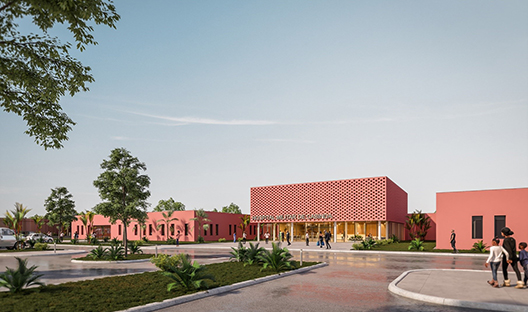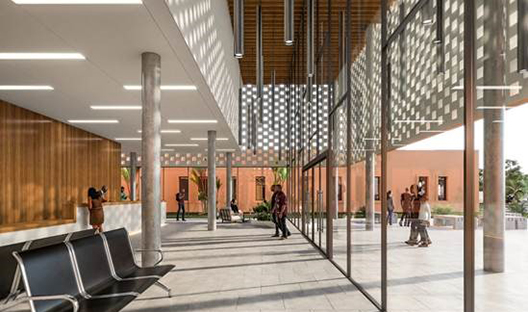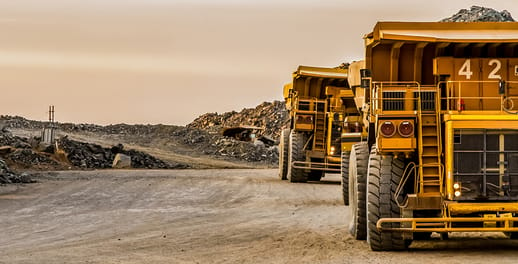Episode 7: Export finance – the sustainability maker
Listen here
Export Finance is a unique source of funding to enable crucial socio-economic development in Africa. It's worth approximately $250 billion a year and is particularly well suited to achieving the SDGs. Investec experts Brian Irvine and Chris Mitman, together with Hussein Sefian from Acre Impact Capital explain what it entails and why private investors want a slice.
Infrastructure enables people
Schools teach us how to learn; housing provides the stability we need to create; transport allows us to collaborate; healthcare keeps us productive.
“Every dollar invested in infrastructure has a multiplier effect on GDP growth. It creates the building blocks for businesses and citizens to flourish,” said Hussein Sefian, founding partner at Acre Impact Capital, an impact adviser and investment manager, during a Future Impact podcast.
He’s right. And to a large extent, the stark and persistent gap between living standards in the northern and southern hemispheres can be explained by differences in infrastructure.
Why has the south fallen behind?
Infrastructure projects are costly and complex, making them inherently risky investment propositions, even more so in the sub-equator developing markets due to issues like:
- Lack of government funding/guarantees to de-risk projects
- Higher levels of political, social and economic instability
- Less robust legal and regulatory frameworks
The bitter result is that many vital infrastructure projects don’t secure the funding they need to break ground and change lives. Investors lose, too: the relatively inelastic demand for the use of infrastructure means the assets tend to produce consistent cashflows with escalations tied to inflation – that could come in handy.
How to bridge (ahem) the gap between the need for infrastructure and the investors who see the opportunity but don’t fancy the risk?

Export finance is a EUR 250 billion-a-year market. Largely, it’s focused on delivering the technology, equipment and related services needed to build essential infrastructure in developing markets. It’s a powerful funding mechanism that’s been around for over a hundred years, and yet so few people know about it.

Old school solution
Chris Mitman, Global Head of Export & Agency Finance at Investec Bank joined Sefian for the podcast. To appreciate his enthusiasm for export finance, let’s first understand who is typically party to these cross-border transactions:
Importer
Usually a developing-world government or corporate that needs funding and skills (engineering, procurement, construction) to develop a large infrastructure project.
Exporters
The offshore companies that export their goods and services to the importing country to build the infrastructure in question.
Export credit agency (ECA)
A private or quasi-governmental institution, usually with a developed-world address, that extends loans or loan guarantees/insurance to the importer to reduce the credit and cashflow risk for the exporters.
Commercial banks
Institutions that structure project-wide finance and arrange/provide additional commercial funding that serves as a ‘down payment’, a critical element that catalyses the ECA backing.
Impact adviser/investor
Private entities that assess the potential impact (social, environmental, economic) of the infrastructure to justify/support the finance provided, and to make its own investment in the deal.
The ECA is the lynchpin in the transaction; without them many infrastructure projects are just too big and risky to be ‘bankable’. What incentive do they have to extend their loans/guarantees/insurance? They do so on condition that a portion of the build is allocated to exporters domiciled in their country.

Export finance in action
After gaining independence in 1975, Angola plunged into a 27-year civil war that strangled infrastructure development. The country’s healthcare system was a casualty – according to a US aid survey, nearly 1 in 5 Angolan children die before their fifth birthday.
Enter export finance. Arranged by a funding consortium including Italy’s ECA and Unicredit S.p.A, South Africa’s Export Credit Insurance Corporation (ECIC) and Investec Bank, an amount of €34 million has been raised to part finance the €225 million price tag of three new Angolan hospitals.
“It will fund the construction of buildings and specialist equipment so we can deliver fully functional hospitals. It also provides for insurance premiums and other financing costs,” said Brian Irvine, Head of African Structured Debt and Trade Solutions.
Within 5 years, the project promises to add 400 beds and 12 operating theatres, as well as orthopedics, trauma, cardiology, maternity, pediatrics, and ICU wards. As is to be expected, the impact of the initiative goes beyond the provision of good healthcare.
In return for the loans and guarantees provided by the ECIC, €14 million worth of South African goods and services will flow into the hospital projects.

There’s a high local labour element during construction, as well as post construction in logistics, maintenance and support staff. Then there are the specialist positions like doctors, sisters, nurses and ambulance drivers. It creates a lot of jobs.

Made for ESG
Export finance owes its growing celebrity to the responsible investing zeitgeist. The infrastructure it can help build will advance a raft of the pressing Sustainable Development Goals (SDGs). Bigger and better hospitals in Angola addresses no less than 5 of the SDGs:
Goal 3: Good health and wellbeing
Goal 6: Clean water and sanitation
Goal 8: Decent work and economic growth
Goal 9: Industry innovation and infrastructure
Goal 11: Sustainable cities and communities
Capital allocators with ESG mandates/policies, long-term investment horizons and prudent risk management criteria are a natural fit for infrastructure projects funded using export finance. Until recently, it was an asset class reserved for commercial banks. That’s changing, too.
Now available
“Acre Impact Capital is opening the export finance asset class to institutional investors, allowing them to get exposure through a fund,” explains Sefian.
More specifically, he and his team run an impact investment fund that targets financial returns alongside environmental and social impact, with a focus on four infrastructure impact themes:
1. Renewable power
2. Health, food and water scarcity
3. Sustainable cities
4. Green transportation
They collaborate with banks like Investec to provide insight around the impact of a particular infrastructure project – who are the beneficiaries? how big is that population? will they be able to afford the services? – typically following their in-depth assessment with an investment. Investec’s Mitman is a fan:
“The market is very excited about sustainability, like children at a birthday party hyped up on Coca-Cola. Acre is helping them channel that energy into the right projects to create maximum impact while generating market-related returns and avoiding the ills of social- or greenwashing. They could influence the whole EUR 250 billion industry.”
Read the paper
The cross-border flows of loans, goods and services, together with the variety of stakeholders, make the export financing of infrastructure projects a collaborative endeavour.
In pursuit of the maximum social and environmental impact – achieved while generating the returns investors need – a white paper, Sustainability in Export Finance, was penned by members from 16 leading banks to explore and share the best (and worst) practices in the export finance sphere.
“We’ve got 35-odd major export credit agencies, and the same number of banks, all doing their own thing when it comes to sustainability. Our research essentially took a giant Polaroid of what everyone's doing in the market, the idea being that the transparency would empower all stakeholders to use export finance to drive sustainable infrastructure development,” concluded Mitman.
If infrastructure enables people, an understanding of export finance will empower sustainability-minded investors, moving them ever closer to that investment utopia of doing good, while doing good.
You may also be interested in
Receive Focus insights straight to your inbox






